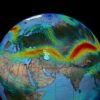Policymakers looking to address food systems challenges have access to new analysis and online tools to show the role aquatic foods can play in tackling nutrient deficiencies and cardiovascular disease as well as reducing the sector’s climate and environmental footprints.
Launched today by the Blue Food Assessment team of experts, the research compiles and analyzes a range of existing national data to uncover the four key roles that aquatic, or “blue,” foods can play to improve national food systems’ performance and sustainability. This, in turn, has broader implications for financiers, processors, retailers, development organizations and fishers themselves.
“Blue foods can play important roles in our diets, societies, and economies, but what exactly this looks like will differ greatly from one country and local setting to another,” said Beatrice Crona, lead author, professor at the Stockholm Resilience Centre at Stockholm University, and co-chair of the Blue Food Assessment.
“Our goal is for policymakers to fully understand the diverse contributions that blue foods can make, but also for them to consider the trade-offs that need to be negotiated to really make the most of the opportunities that blue foods provide.”
Published in Nature and titled “Four ways blue foods can help achieve food system ambitions across nations,” the paper looks at the potential for blue foods to deliver benefits and improvements across four policy dimensions: B12 and omega-3 nutrient deficiency, high rates of cardiovascular disease associated with excessive red (particularly processed) meat consumption, high environmental impacts, and climate adaptation and resilience to safeguard the contribution of blue food systems to nutrition, just economies, livelihoods and cultures.
For instance, researchers found that policymakers in countries with high environmental food footprints and high levels of cardiovascular disease—typified by developed countries in Europe and North America—should focus on improving production and access to blue foods, which can act as a substitute for the consumption of more impactful red meats.
In contrast, the paper suggested that policymakers in nations characterized by high environmental food footprints and high nutrient deficiencies could choose to support greater diversity of blue food production and promote lower cost blue foods. The research indicated farmed bivalves or small pelagic fish, such as sardines and herrings, can benefit less affluent populations while having low environmental footprints.
“By further customizing the different parameters in the online tool, decision-makers can explore the blue food policies most relevant for their national setting and use the paper to inspire blue food policies that can overcome existing environmental and nutritional challenges,” said Jim Leape, Co-Director of the Stanford Center for Ocean Solutions, a key partner in the Blue Food Assessment.
The landmark Blue Food Assessment is a comprehensive body of academic research aimed at informing the sustainable contribution of aquatic, or “blue,” foods towards the healthy diets of the future.
The Assessment’s published research has already shown that 93 countries have 10% or more of their population exposed to nutrient deficiencies despite blue food availability, and that access to more affordable blue foods could prevent 166 million micronutrient deficiencies worldwide.
The assessment has also shown that blue food consumption is set to increase by 80% in edible weight by 2050, with blue foods already supporting the livelihoods of up to 800 million people worldwide. Yet the opportunities to take advantage of the positive contribution of blue foods to healthy and sustainable diets have not yet been fully realized.
This latest paper brings together the insights from the entire Blue Food Assessment to provide a solid scientific base, and an interactive tool, to help policymakers explore blue food related data from their own nations, and be inspired to craft policies and actions that can realize the contributions blue foods can make to food systems around the world.
More information:
Beatrice Crona, Four ways blue foods can help achieve food system ambitions across nations, Nature (2023). DOI: 10.1038/s41586-023-05737-x. www.nature.com/articles/s41586-023-05737-x
Provided by
Stockholm University
Citation:
Leveraging aquatic foods can help policymakers address multiple global challenges, new analysis shows (2023, February 22)



